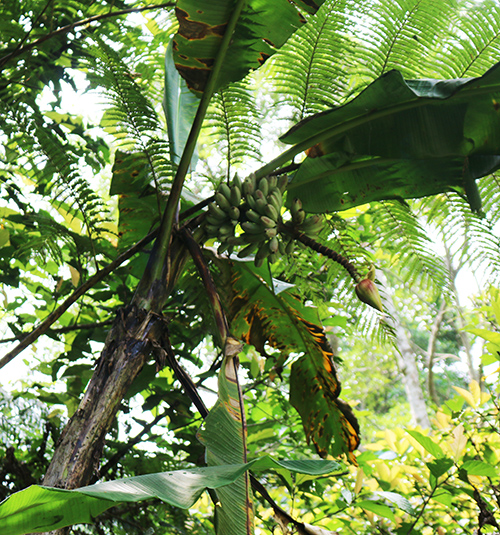Musa itinerans var. chinensis Information
Identification:
Plant normal, suckering close to parent plant 10-30 cm, to 12 suckers, position vertical; mature pseudostem to 4 m high, to 15 cm diam. at base,
covered with varying amounts of dead brown leaf sheaths, underlying colour light green with large redbrown blotches, shiny, sap watery milky. Petiole to 50 cm, petiole canal margins curved inward, petiole bases winged and clasping pseudostem without corrugated auricles, with sparse black-purple blotches; leaf habit intermediate, lamina to 250 x 50 cm, narrowly elliptic, truncate at apex, green abaxially and adaxially, appearance shiny, surface sparsely covered with wax coating, leaf bases asymmetric, both sides rounded and auriculate, midrib dorsally green and ventrally light green, with corrugated lamina. Inflorescence semi-pendulous and then falling vertically downward, peduncle to 30 cm, to 5 cm diam., puberulent with short hairs, green to rusty brown; sterile bracts 2, bracts persistent at the opening of first female flowers. Female bud lanceolate, to 31 x 9 cm, bracts red-purple with paler pinkish lines externally, bright yellow internally, without wax, not imbricate, lifting several bracts at a time, these revolute before falling; basal flowers female, ca.
11 cm, ovary light green, arrangement of ovules in 4 rows per locule, compound tepal ca. 4.8 cm, with 2 prominent thickened keels and hyaline margins, yellow to orange, free tepal ca. 3 cm, rounded, translucent white with thickened keel; stamens 5, without fertile pollen, ca. 4 cm, yellow; stigma ca. 0.8 cm diam., white. Male bud ovoid, ca. 1569 cm, bracts pale red-purple externally with a yellow margin, bright yellow internally, with sparse wax outside, not imbricate, lifting 2 bracts at a time, these both revolute before falling; male flowers on average 21 per bract in 2 rows, falling with the bract, compound tepal ca. 4.8 cm, cream, with 2 thickened
keels, ribbed at the dorsal angles, with 5-toothed orange apex, central lobes smaller than outer lobes, free tepal ca. 3 cm, translucent white, rounded, smooth, with thread-like orange apex; stamens 5, filaments white, anthers orange, anthers and style at the same level; stigma cream; ovary straight, pale green, without pigmentation. Fruit bunch lax, with 7
hands and 17 fruits per hand on average, in 2 rows, fingers curved toward the stalk, individual fruit ca. 10 cm, slightly curved and ridged, pedicel ca. 2.5 cm, glabrous, fruit apex blunt-tipped, with no floral relicts, immature fruit peel pale green, becoming yellow at maturity, immature fruit pulp white, becoming cream to brown and soft at maturity; seeds wrinkled, ca. 5 mm diam., 250 to 270 seeds per fruit.
General Information:
It can withstand seasonal frost and snow, which it faces each winter in the northern portions of its range. There frost kills the leaves, leaving the pseudostem alive from which new leaves rapidly emerge in spring, February
to March. This delays any flowering to July to September in northern regions. Variety chinensis is cultivated commonly at elevations up to 2200 m as fodder by farmers (Hakkinen, pers. obs.).
Distribution:
Native to, China
Occurs all over southern China in subtropical regions at elevations from 300 to 1800 m, along roadsides, in river valleys and ravines, and on steep slopes.
Location: China (24.309723°N, 111.005859°E)
Observations
Musa itinerans var. chinensis Overlay Image ©2025 Trebrown - No re-distribution without permission.

